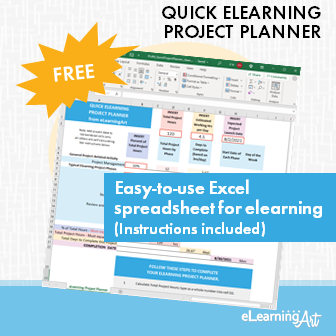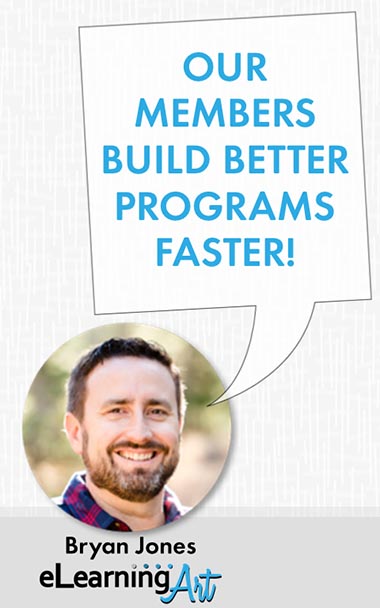eLearning Development Calculator
Quickly Estimate eLearning Course Length, Development Time and Cost
ULTIMATE GUIDE TO ELEARNING DEVELOPMENT
- Plan Your eLearning Projects
- Manage Your eLearning Projects
- Structure & Script eLearning
- Design & Prototype eLearning
- Visualize & Storyboard eLearning
- Develop & Build eLearning
- Publish & Deliver eLearning
Bonus 1: eLearning Development Calculator
Bonus 2: eLearning Best Practices Pro Tips
One thing that consistently challenges people during the eLearning development process is how to effectively estimate the number of hours that will be needed to complete an elearning project, and the associated cost.
Estimating costs and time in instructional design and elearning development is not actually too complicated to get a reasonably accurate number to help you create a project plan, communicate with your stakeholders, and keep the project on the road.
There are two primary factors that impact the number of hours. These are:
1: How long will the delivered program be?
2: How much interactivity will be included in the delivered program?
That will get you to your development hours. Then you just need to know:
3. What are the hourly elearning development costs?
Our eLearning Development Calculator helps you estimate your course length, the development time, and your hourly costs to calculate your total course cost. Check your project time and costs now, or read more about these factors just below the tool.
Get our free eLearning project plan template!
Now that you have your project hours from our calculator, you can set up a full project calendar with just a few clicks using this handy Excel spreadsheet.

Now, let’s take a closer look at the two factors that affect program development time most significantly.
#1: Estimate eLearning Course Length
How long will the delivered program be?
There are a number of ways to determine the “seat time,” or course length, of the planned-for program. In general, you’re seeking a number of minutes that everyone can agree on. Sometimes that’s easy, sometimes you need to “back into” the number based on source material or other factors.
Here’s a summary of some possibilities for finding the number of minutes of runtime for your delivered program:
If you have …
A statement from a sponsor or SME that the elearning program should a certain number of minutes:
- Locate this information … How many minutes will the delivered program run?
An instructor-led course or similar information, but no slide deck:
- Locate this information … How many hours of actual instructional time are typical for the program? (Don’t count breaks and lunch.)
- To convert to Minutes … Hours ❌ 60 minutes
A slide deck (or several) to convert to elearning:
- Locate this information … How many slides are present? How text-dense are the slides? (If text dense, more slides will be needed in elearning. Multiply the number of slides present X 1.25 to compensate, and use this result.)
- To convert to Minutes …Total slide count ➗ 2.2 slides per minute
- WARNING: Try to find other data points besides just slide count. Because the complexity of the slides and project vary so widely. Only use this as a starting point for your conversation.
A script or similar document that will be used to build the program:
- Locate this information … How many words are given for the voiceover?
- To convert to Minutes … Total word count ➗150 words per minute
A pile of paper, some notes from a training, or some other “messy source”:
- Locate this information … How many minutes will the delivered program run?
OK, drum roll please!!
It’s time to do the simple math needed to project the time estimate for your elearning project. At this point, you’ve done the following:
- Determined the interactivity level of the to-be-delivered project.
- Considered where your project work effort falls on the low-average-high Level Factor spectrum.
- Estimated the total number of minutes for your to-be-delivered project.
Now, all you need to do is some simple math:
Minutes ❌ Level Factor = Total minutes development time ➗ 60 minutes = Total hours of development time.
Once you’ve considered the Level Factor, it’s time to answer the next question.
#2: Estimate eLearning Development Time
How much interactivity will be included in the delivered program?
Most development models rank delivered training programs based on the level of interactivity incorporated into the program. This, in turn, impacts the number of hours that will be required for development. The rule of thumb is the more interactive, the more hours needed to build.
Ideally, the inclusion of interactivity, and how much, should be instructional design decisions. You want to think about how to best ensure that the material engages viewers so learning transfer can happen. In the real world, though, program requirements and expectations are often heavily influenced by stakeholders, available resources, and what’s “usually” done.
A typical breakdown comes from Chapman Alliance:
- Level 1 – Basic: This is a simple elearning program, similar to an automated PowerPoint. Sometimes referred to as “click and read.” A quiz or similar assessment may be present.
- Level 2 – Interactive: This is an elearning program that combines click and read-type content with learner interactions such as drag and drop, tabbed interactions, timelines, etc. There is a limited amount of branching in this level of program. This level would be considered typical of most elearning produced today.
- Level 3 – Advanced: These programs incorporate significant amounts of branching, gamification, animations, and/or customizations for a unique end-product.
Instructional and Training Design Ratios
Because more interactive programs take longer to develop, these three levels also increase in the hours required for development. This gives us some useful factors for figuring out the dev time needed for our own projects. Thanks to the Chapman Alliance research, we have some pretty accurate numbers — we call them Level Factors — to use, as follows:
- Level 1 – Basic
- Low: 49
- Average: 87
- High: 125
- Level 2 – Interactive
- Low: 127
- Average: 197
- High: 267
- Level 3 – Advanced
- Low: 217
- Average: 466
- High: 716
So, what is a Level Factor, exactly? It is a ratio reflecting the number of minutes (or hours) required to develop 1 minute (or hour) of elearning at a given interactivity level. For example, on average, one minute of a Level 2 program will require 197 minutes (or just over 3.25 hours) of development time.
Keep in mind that this is a start-to-finish number that includes every aspect of project development, from the very first discussions all the way through to final LMS testing! As such, the total minutes requirement is spread out over tasks, time, and, likely as not, people.
If some portions of the total project will not be part of your own time estimate (say, if you are starting from a completed script and will not need to produce that), consider using the Low Level Factor. Or, if your project is pushing the limits of its level, consider using the High Level Factor.
But why do the math? We’ve created an eLearning development calculator for the job! You can use it calculate both your course length and the interactivity Level Factor, and you’ll instantly have the hours to development for your project at each of the interactivity levels. Then it’s on to calculate your elearning development costs, which we’ll discuss next!
#3: Calculate eLearning Development Costs
eLearning development costs are calculated by multiplying the development time (in hours) by the hourly rate. So:
eLearning Development Cost = Development Hours X Cost Per Hour
We previously calculated development hours, in the first and second steps, by multiplying course length by a development ratio based on the level of interactivity.
Development Hours = Course Length X Development Ratio
Now it’s time to figure out the remaining variable, Cost Per Hour.
There are the two types of hourly costs you may consider for this calculation, depending on whether you contract with an outside freelancer or agency to complete your project or have an internal employee who can do the work. Let’s take a look at both of these here.
External Costs for Freelancers and Agencies
One nice thing about the rates charged by a freelancer or by a custom development or staffing services company (or “agency”) is that they’re easy to apply to our equation. The freelancer or agency bears the cost of overhead, meaning that we can take their hourly rate as our cost with no additional cost to apply to it. For example, if they charge $50 per hour, our hourly cost is $50 per hour. Easy peasy!
Outsourced rates will be different depending on if you’re outsourcing to a custom elearning development company or hiring a contractor through a staffing service. Rates will differ greatly between U.S. based or offshore. Let’s take a closer look.
Freelance Rates for Instructional Designers and eLearning Developers
A good base-level average rate for freelance elearning developers and instructional designers is $50 per hour, but rates vary widely by experience and geography, from $30 or less per hour upwards of $100 per hour.
In our calculator, we’ve set the hourly rate at $50 per hour. You can adjust this in your own calculation.
If you need a very accurate cost projection and are planning to work with a freelancer, you’ll want to do some research about freelance rates in your area. (Which is another way of saying “Shop around!” You’ll learn a lot about capabilities and rates by doing so.)
If you’re just looking for a ballpark estimate, here are a few data points and articles you can use to adjust your numbers:
- Upwork, the freelancing site, uses the following freelance rate ranges in 2022 for instructional designers:
- Beginner: $30 per hour
- Intermediate: $59 per hour
- Advanced: $125 per hour
- Christy Tucker does a nice job summarizing instructional design freelance rates in the article and mentions (a now hidden) range from ID Lance of:
- Newbie: $35-45 per hour
- 1-3 years of experience: $45-60 per hour
- 4+ years of experience: $60-75 per hour (although Christy notes this should be higher)
- According to Richard Watson, author of How to Become an e-Learning Freelancer, in the United States, the typical range he sees eLearning freelancing charge is between $50-$130 depending on 4 factors: experience level, complexity of the material, client turn-around time, and the value the contractor can bring to the project.
Rates for Custom eLearning Development Companies
Expect to pay around $100 per hour for projects completed by an agency offering custom elearning development services, but know that this ranges widely.
It’s not surprising that agency rates are higher, right? A project services agency is typically structured as a business, with employees on payroll, overhead costs, and non-billable time to cover. As such, agency rates charged to clients reflect the business imperative of covering costs while still making a profit. On the plus side, an agency also can also bring a lot of expertise and management to your project.
Custom elearning development is often quoted based on total project cost, without reference to the hours required to complete the project. If you already have a project quote, simple division using the estimated hours generated by the calculator will give you an hourly rate.
As always, agency rates vary widely on factors such as geography and experience. In the U.S., you may be able to find an agency that will complete your project for around $100 per hour, but the per hour rate could be as high as $400 or more. An offshore option could be as low as $20-50, but per hour rates will also vary widely. In short, this is another “shop around” opportunity!
Employee Costs for Instructional Design and eLearning Development
You may have an internal associate available to complete your project, or be considering hiring one. If so, you can calculate the per hour cost to include in the development calculator by using the information below. The goal is to land on the associate’s per hour rate then add overhead (or “load’) to get to the true per hour cost of employee work to the company.
Here’s how to calculate that. We’ll start by looking at what the internal associate earns.
Hourly Associate
If you’re paying someone hourly, great! You already know their hourly base rate. 🙂 Note that and jump to the “load factor” section below.
Salaried Associate
If you’re working with a full time salaried employee, it’s pretty standard to use 2,080 work hours in a year. We get to that by taking 52 weeks per year and multiplying it by 40 hours per week.
Hourly employee base rate = Annual salary / 2,080 hours
If you’re unsure of the salary paid to an internal instructional designer/elearning developer, you can use these data points for U.S. averages:
- $85,466 average salary U.S. Devlin Peck 2021 report
- $84,421 average salary U.S. eLearning Guild 2018 Salary Report
- $63,740 average salary U.S. O*Net OnLine (US Department of Labor)
(Note that average salaries vary widely in the U.S. depending on state and city where a position is seated. At the O*Net OnLine site, you can drill down on average reported salaries for your state and local area and adjust your own calculation as needed.)
So, let’s take an average of the three numbers listed above (that is, $77,876, rounded up to $78,000) to use in calculating the average per hour rate for a salaried instructional designer:
$78,000 per year divided by 2080 hours per year = $37.50 per hour (average, before loading)
We use this number in our calculator.
Load factor for true cost of employee for the business
Of course, the true cost of an employee to their employer is greater than just the cost of the wages they are paid. From the employer’s perspective, there are additional costs incurred for each employee, including, for example, the following:
- Benefits
- Overhead (think office space, etc)
- Payroll taxes
To get a true sense of the per hour cost of your internal instructional designer/elearning developer, these costs must also be considered. A simple calculation gives you the “loaded” rate, and this, in turn,better reflects the actual cost of an employee to the company.
According to the Small Business Association (based on research from MIT), a good rule of thumb is 25%-40% on top of the employee’s salary. We’ve used the rounded average of 33% in our calculator.
So our $37.50 per hour instructional designer/elearning developer actually costs the company about $50 per hour loaded. That’s:
$37.50 per hour + ($37.50 per hour X 33%) = $49.88 per hour loaded, rounding to $50 per hour.
Total Cost
Whether you are planning to use an external (freelancer or agency) or internal (employee) instructional designer to build your program you now know your cost per hour. With that information you can complete the equation with which we began this section and see your total cost:
eLearning Development Cost = Development Hours X Cost Per Hour
For example, let’s assume that we’re asking an internal instructional designer to develop a 20-minute elearning program with a medium level of interactivity. (For this calculation, we’ll use the averages shown above; your situation may require different numbers.)
A typical 20-minute eLearning course will cost $3,275.45 for an employee to develop.
We got to this using our calculator default example of:
20 minutes (A course with 20 minutes of runtime) X 197 development ratio (level 2 interactivity, average) = 65.67 hours.
65.67 hours X $49.88 (loaded hourly cost of a $50,000 salaried employee) =$3,275.45.
So, a typical 1-hour eLearning course will cost $9,826.36 for an employee to develop.
And, BOOM!!
That’s a great starting point. Now adjust any of the numbers in the calculator and you’ll get a number that’s more accurate for the project you have in mind. Enjoy!
eLearning Development FAQ
A average 1-hour interactive elearning course will take 197 hours to develop. But development of a 1-hour elearning course can range between 49 hours for the low end of the range of a “basic” course to 716 hours for the high end of the range of an “advanced” course.
You can use our eLearning Development Calculator to enter any length course and see the low, average, and high ranges for estimating basic, interactive, and advanced courses.
An average 1 hour instructor led course will take 43 hours to develop.
Similar to the development ratios for eLearning mentioned in the article above, the Chapman Alliance research provides the following development to seat-time ratios for classroom training:
- 22:1 – Simple, with minimal support materials.
- 43:1 – Intermediate, with some support materials.
- 82:1 – For complex subject and significant support material.
With those ratios and the length of the training, you can follow the exact same method to calculate instructor-led training (ILT) times.
Instructional designers earn an average salary of $77,876 in the United States. This is calculated using the average of these 3 data point:
- $85,466 average salary U.S. Devlin Peck 2021 report
- $84,421 average salary U.S. eLearning Guild 2018 Salary Report
- $63,740 average salary U.S. O*Net OnLine (US Department of Labor)
Rates for contract instructional designers vary widely — between $30-100 per hour.
If you’re new to building eLearning or training, start with our guide:
How to Design Workplace Learning Like a Pro – Start with These 5 Dangerous Questions


